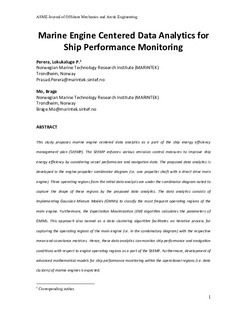| dc.contributor.author | Perera, Lokukaluge Prasad | |
| dc.contributor.author | Mo, Brage | |
| dc.date.accessioned | 2017-11-02T13:58:38Z | |
| dc.date.available | 2017-11-02T13:58:38Z | |
| dc.date.created | 2017-02-06T13:59:45Z | |
| dc.date.issued | 2017 | |
| dc.identifier.citation | Journal of Offshore Mechanics and Arctic Engineering-Transactions of The Asme. 2017, 139 (2), . | nb_NO |
| dc.identifier.issn | 0892-7219 | |
| dc.identifier.uri | http://hdl.handle.net/11250/2463765 | |
| dc.description.abstract | This study proposes marine engine centered data analytics as a part of the ship energy efficiency management plan (SEEMP). The SEEMP enforces various emission control measures to improve ship energy efficiency by considering vessel performance and navigation data. The proposed data analytics is developed in the engine-propeller combinator diagram (i.e. one propeller shaft with a direct drive main engine). Three operating regions from the initial data analysis are under the combinator diagram noted to capture the shape of these regions by the proposed data analytics. The data analytics consists of implementing Gaussian Mixture Models (GMMs) to classify the most frequent operating regions of the This study proposes marine engine centered data analytics as a part of the ship energy efficiency management plan (SEEMP). The SEEMP enforces various emission control measures to improve ship energy efficiency by considering vessel performance and navigation data. The proposed data analytics is developed in the engine-propeller combinator diagram (i.e. one propeller shaft with a direct drive main engine). Three operating regions from the initial data analysis are under the combinator diagram noted to capture the shape of these regions by the proposed data analytics. The data analytics consists of implementing Gaussian Mixture Models (GMMs) to classify the most frequent operating regions of the main engine. Furthermore, the Expectation Maximization (EM) algorithm calculates the parameters of GMMs. This approach also named as a data clustering algorithm facilitates an iterative process for capturing the operating regions of the main engine (i.e. in the combinatory diagram) with the respective mean and covariance matrices. Hence, these data analytics can monitor ship performance and navigation conditions with respect to engine operating regions as a part of the SEEMP. Furthermore, development of advanced mathematical models for ship performance monitoring within the operational regions (i.e. data clusters) of marine engines is expected. | nb_NO |
| dc.language.iso | eng | nb_NO |
| dc.rights | Navngivelse-Ikkekommersiell-DelPåSammeVilkår 4.0 Internasjonal | * |
| dc.rights.uri | http://creativecommons.org/licenses/by-nc-sa/4.0/deed.no | * |
| dc.subject | Engines | nb_NO |
| dc.subject | Propellers | nb_NO |
| dc.subject | Ships | nb_NO |
| dc.subject | Navigation | nb_NO |
| dc.subject | Vessels | nb_NO |
| dc.subject | Algorithms | nb_NO |
| dc.title | Marine Engine-Centered Data Analytics for Ship Performance Monitoring | nb_NO |
| dc.type | Journal article | nb_NO |
| dc.type | Peer reviewed | nb_NO |
| dc.description.version | acceptedVersion | nb_NO |
| dc.source.pagenumber | 8 | nb_NO |
| dc.source.volume | 139 | nb_NO |
| dc.source.journal | Journal of Offshore Mechanics and Arctic Engineering-Transactions of The Asme | nb_NO |
| dc.source.issue | 2 | nb_NO |
| dc.identifier.doi | 10.1115/1.4034923 | |
| dc.identifier.cristin | 1447435 | |
| dc.relation.project | Norges forskningsråd: 237917 | nb_NO |
| cristin.unitcode | 7566,7,0,0 | |
| cristin.unitname | Maritim | |
| cristin.ispublished | true | |
| cristin.fulltext | postprint | |
| cristin.qualitycode | 2 | |

